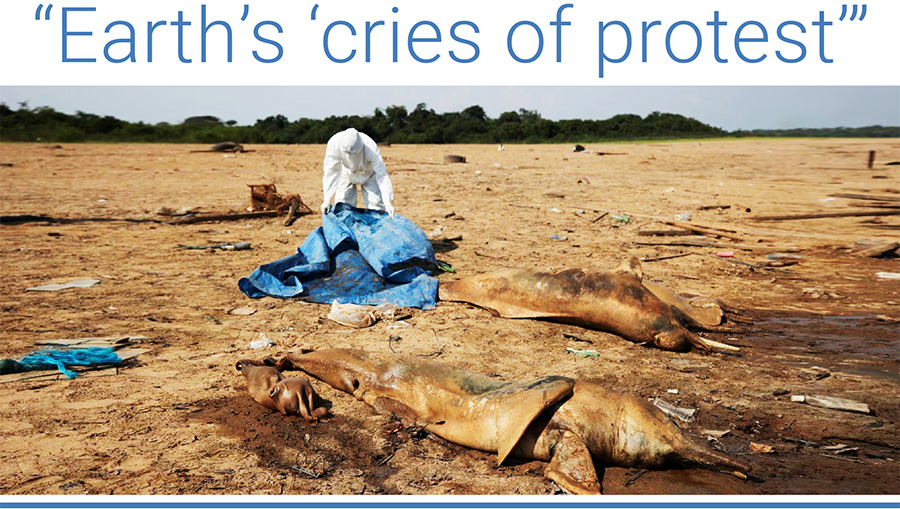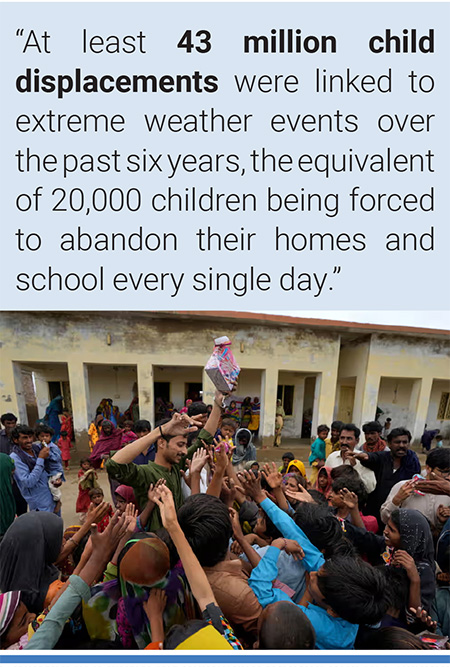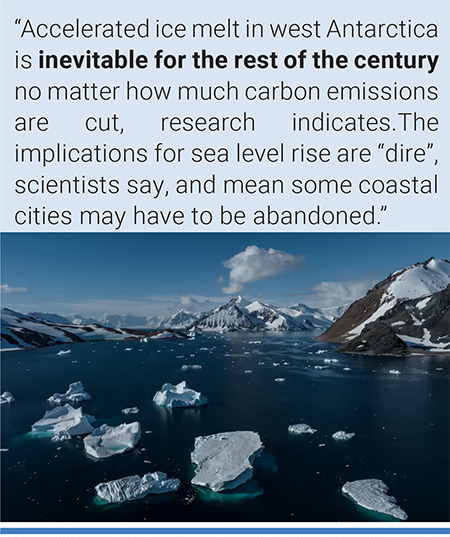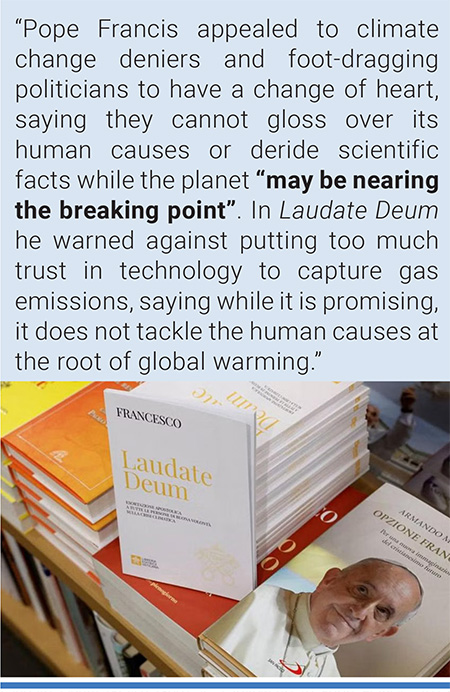Monthly Summaries
Issue 82, October 2023
[DOI]

A researcher from the Mamirauá Institute for Sustainable Development recovers dead dolphins from Lake Tete, Amazonas Brazil that has been affected by high temperatures and drought on October 2. Photo: Bruno Kelly/Reuters.
October media coverage of climate change or global warming in newspapers around the globe dropped precipitously, down 22% from September 2023. Coverage in October 2023 also dipped a worrying 18% from October 2022 levels. International wire services were consistent with the trend, decreasing 15% while radio coverage too went down 13% from September 2023. Compared with September 2023, coverage was considerably down as well in all regions: Latin America (-7%), Oceania (-14%), Asia (-20%), North America (-24%), the European Union (EU) (-25%), the Middle East (-26%), and in Africa (-26%). Figure 1 shows trends in newspaper media coverage at the global scale – organized into seven geographical regions around the world – from January 2004 through October 2023.

Figure 1. Newspaper media coverage of climate change or global warming in print sources in seven different regions around the world, from January 2004 through October 2023.
Our 26-member team at the Media and Climate Change Observatory (MeCCO) continues to provide three international and seven ongoing regional assessments of trends in coverage, along with 16 country-level appraisals each month. Visit our website for open-source datasets and downloadable visuals.
Children at a camp for displaced people due to Cyclone Biparjoy in Badin, Pakistan's southern district in the Sindh province in June. Photo: Fareed Khan/AP. |
Moving to the content of October 2023 coverage, scientific findings appeared to dominate media attention. Among them, a UNICEF report entitled ‘Children Displaced, Climate Change’ garnered coverage in several outlets. For example, Guardian journalist Nina Lakhani reported, “At least 43 million child displacements were linked to extreme weather events over the past six years, the equivalent of 20,000 children being forced to abandon their homes and school every single day, new research has found. Floods and storms accounted for 95% of recorded child displacement between 2016 and 2021, according to the first-of-its-kind analysis by UNICEF and the Internal Displacement Monitoring Centre (IDMC). The rest – more than 2 million children – were displaced by wildfires and drought. Displacement is traumatic and frightening regardless of age, but the consequences can be especially disruptive and damaging for children who may miss out on education, life-saving vaccines and social networks… the greatest proportion of child displacements were in small island states – many of which are facing existential threats due to the climate emergency – and in the Horn of Africa where conflict, extreme weather, poor governance and resource exploitation overlap. A staggering 76% of children were displaced in the small Caribbean island of Dominica, which was devastated by Hurricane Maria in 2017, a category 4 Atlantic storm that damaged 90% of the island’s housing stock. Storms also led to more than a quarter of children being displaced in Cuba, Vanuatu, Saint Martin and the Northern Mariana Islands. Somalia and South Sudan recorded the most child displacements due to floods, affecting 12% and 11% of the child population respectively… Children Displaced in a Changing Climate is the first global analysis of the children driven from their homes due to floods, storms, droughts and wildfires, and comes as weather-related disasters are becoming more intense, destructive and unpredictable due to fossil-fuel driven global heating. The report’s stark numbers are almost certainly an undercount due to major gaps in reporting drought and slow onset climate impacts such as rising sea level, desertification and rising temperatures”.
Moving deeper into October, a study from Nature Scientific Reports that examined rapid intensification of Atlantic Ocean storms – with links to a changing climate – earned media coverage. For example, Washington Post journalist Ian Livingston reported, “The list of major hurricanes that rapidly intensified before hitting the United States in recent years is long and memorable: Harvey, Irma, Maria, Michael, Laura, Ida, Ian and Idalia. All of those storms, starting in 2017, developed explosively over the Atlantic Ocean. Generally, this rapid escalation is increasingly recognized as part of a global phenomenon related to climate change and its associated warming of ocean waters — but until the past couple of years, the Atlantic’s inclusion in the trend was somewhat murkier. Now, research shows that this rapid intensification is on the rise across the Atlantic basin at multiple time scales. The author of a study published Thursday, Andra Garner, an assistant professor at Rowan University in New Jersey, also highlights regions in which this intensification has become more likely, such as the western Caribbean Sea”.
As October moved along, a Nature Climate Change study finding significant Antarctic ice sheet loss in the coming years sparked many media accounts. For example, USA Today journalist Doyle Rice reported, “The horse has left the barn. Melting of the huge West Antarctic ice sheet has apparently passed the point of no return and may be "unavoidable," a new study reports Monday. In fact, because of human-caused climate change, the West Antarctic ice sheet will continue to increase its rate of melting over the rest of this century, no matter how much we reduce fossil fuel use, according to the study, which was published in the peer-reviewed journal Nature Climate Change…The ice sheet collapse is a worrying climate tipping point, experts say, because it has the potential to raise global sea level by up to 17 feet. Though the full melt would take hundreds of years, it would be enough to reshape where and how people live in the future”. Meanwhile, Guardian environment editor Damian Carrington noted, “Accelerated ice melt in west Antarctica is inevitable for the rest of the century no matter how much carbon emissions are cut, research indicates. The implications for sea level rise are “dire”, scientists say, and mean some coastal cities may have to be abandoned. The ice sheet of west Antarctica would push up the oceans by 5 metres if lost completely. Previous studies have suggested it is doomed to collapse over the course of centuries, but the new study shows that even drastic emissions cuts in the coming decades will not slow the melting. The analysis shows the rate of melting of the floating ice shelves in the Amundsen Sea will be three times faster this century compared with the previous century, even if the world meets the most ambitious Paris agreement target of keeping global heating below 1.5C above pre-industrial levels. Losing the floating ice shelves means the glacial ice sheets on land are freed to slide more rapidly into the ocean. Many millions of people live in coastal cities that are vulnerable to sea level rise, from New York to Mumbai to Shanghai, and more than a third of the global population lives within 62 miles (100km) of the coast. The climate crisis is driving sea level rise by the melting of ice sheets and glaciers and the thermal expansion of sea water. The biggest uncertainty in future sea level rise is what will happen in Antarctica, the scientists say, making planning to adapt to the rise very hard. Researchers said translation of the new findings on ice melting into specific estimates of sea level rise was urgently needed”.
Melting icebergs on Horseshoe island in west Antartica. The ice sheet of west Antarctica would push up the oceans by 5 metres if lost completely. Photo: Anadolu Agency/Getty Images. |
The most abundant media coverage on this theme, however, came from the publication of a study in Bio science that provided an updated report of the state of Earth’s changing climate in 2023. For example, ABC News reporter Daniel Manzo noted, “Forecasts about the negative effects of human-caused climate change are not uncommon, but new research published Tuesday makes even more dire claims, declaring that "life on planet Earth is under siege" and that "we are pushing our planetary systems into dangerous instability." The study, titled "The 2023 State of the Climate Report: Entering Uncharted Territory" and published in the journal Bioscience, points to specific climate events in 2023 to support its findings, including exceptional heat waves across the globe, historic and record-breaking warm ocean temperatures, and unprecedented low levels of sea ice surrounding Antarctica. The 12 international scientists who created the report indicated that in so far in 2023, there have been 38 days with global average temperatures more than 1.5 degrees Celsius above pre-industrial levels. The U.S. National Oceanic and Atmospheric Administration and Europe's Copernicus Climate Change Service earlier this month indicated that 2023 will likely go on record as the hottest year ever recorded. What's more, the highest average Earth surface temperature ever recorded was in July, according to the report, which also notes that may be the highest surface temperate the Earth has experienced in the last 100,000 years. The research team, which included scientists from the United States, Australia, Germany, Brazil, the United Kingdom, China, and the Netherlands, says that anthropogenic global heating – meaning global heating caused or amplified by humans – is the key driver in recent extreme climate events. The team also took into account that some of these events are complex and are at least partially driven by non-human factors, including water vapor effects from an underwater volcano, as well as dust from Africa, and the El Niño global climate pattern. The researchers also point to "minimal progress" by humanity to stop the impacts of anthropogenic climate change". Although the consumption of renewable energy (solar and wind) grew a robust 17% between 2021 and 2022, it remains roughly 15 times lower than fossil fuel energy consumption," the report states”.
Also in October, there were several ecological and meteorological dimensions of climate change or global warming. To illustrate, droughts and floods in several places such as Brazil, Cameroon, France, Vietnam, and Myanmar – with connections made to climate change – were evident in news reporting around the world. For example, El País journalist Joan Royo Gual noted, “The lack of rain has caused a sharp decrease in the flow of rivers that is already affecting the supply of drinking water and subsistence agriculture, and that threatens to leave hundreds of thousands of people living incommunicado in the most remote and vulnerable corners of Brazil. The rivers in the north of the country are like aquatic highways, practically everyone (and food, shops, medicines) moves by river. According to the authorities, more than half a million people could be affected by the shortage of water and food in the coming weeks…El Niño is partly to blame, since this climate phenomenon inhibits the formation of clouds and rain, but the scenario has been worsened by the abnormal warming of the waters of the North Atlantic, related to climate change”. As a second example, BBC News correspondents Paul Njie and Wycliffe Muia reported, “At least 30 people have been killed in landslides caused by heavy rains in Cameroon's capital Yaoundé, the emergency services have said. A local radio station put the death toll at 40, saying that many people are still missing. Rescue efforts were hampered by floods, forcing locals to pull bodies out of the debris with their bare hands… Poverty and poor infrastructure make communities such as Mbankolo more vulnerable to extreme weather such as heavy rain, which is becoming more frequent and intense in Africa due to climate change, according to United Nations climate experts”.
Ongoing heat waves and extreme high temperatures in October also contributed to news reporting on climate change in October. For example, on October 4 Guardian journalist Eva Corlett wrote, “After the northern hemisphere sweltered through the hottest summer in human history, New Zealand’s usually cool start to spring has also hit record high temperatures that are usually reserved for its summer months. The country recorded its hottest September on record, with every region in the country experiencing above-average temperatures, with one area hitting 29.6 C. Data from the National Institute of Water and Atmospherics (NIWA) shows the nationwide average temperature was 11.9C, 1.3C warmer than the 1991-2020 September average and the hottest since records began in 1909”. Then, on October 14 Associated Press journalist Louise Delmott reported, “As Earth sweltered to its hottest Northern Hemisphere summer ever recorded, Hong Kong shared in the misery. The city, already known for oppressive humidity, endured its own record-breaking summer for heat, including August’s monthly mean temperature of 29.7 degrees Celsius (85.4 Fahrenheit). Residents spent half the month under very hot weather warnings. In the weeks since fall officially began in late September, temperatures have been slowly dropping. But the sweltering summer won’t soon be forgotten, and for many residents there is worry about future heat waves. As in so many other places, the burden of this summer’s heat often fell hardest on Hong Kong’s most vulnerable, who don’t have or can’t afford air conditioning to cope with the heat”. Meanwhile, on October 17 Guardian correspondent Charles Pensulo wrote, “Malawians endured the country’s hottest weekend on record, with temperatures reaching nearly double the seasonal average. The heatwave began last Thursday with the government warning people to stay out of the sun, to keep hydrated, and avoid alcohol and caffeine. Some school buildings in the south of the country were evacuated, and children were taught in the shade of playground trees. By Saturday, parts of Malawi saw temperatures of 43C (109F), compared with an average of nearly 25C (77F) for the time of year. The temperatures had dropped by Monday, but in an advisory last week the country’s Department of Climate Change and Meteorological Services warned of a “prolonged period of hot and uncomfortable weather” throughout October. Kick-off for Malawi’s Super League football matches was delayed for 30 minutes in an attempt to avoid the worst of the heat. Players were encouraged to take regular water breaks during matches”.
As a final example of October reporting about ecological and meteorological-themed stories about climate change, hurricane Otis – a category 5 storm – that struck Mexico led to several news accounts that connected this event to global warming and climate change. For example, CNN journalist Rachel Ramirez reported, “The rapid intensification Hurricane Otis underwent in the hours before it slammed into southern Mexico is a symptom of the human-caused climate crisis, scientists say – and one that is becoming more frequent. When it happens right before landfall, as it did with Otis, it can catch coastal communities by surprise with little time to prepare. The hurricane’s intensification was among the fastest forecasters have ever seen: its top-end windspeed increased by 115 mph in 24 hours. Only one other storm, Hurricane Patricia in 2015, exceeded Otis’ rapid intensification in East Pacific records, with a 120-mph increase in 24 hours. The term rapid intensification refers to when a storm’s winds strengthen rapidly over a short amount of time. Scientists have defined it as a wind speed increase of at least 35 mph in 24 hours or less, and it generally requires significant ocean heat. The National Hurricane Center said Otis strengthened so fast on Tuesday that it had “explosively intensified.” Otis “took full advantage of a warm patch of ocean” that was roughly 88 degrees Fahrenheit, said Brian McNoldy, an atmospheric scientist at the University of Miami – more than enough ocean heat to fuel a monster storm. More than 90% of warming around the globe over the past 50 years has taken place in the oceans, according to the National Oceanic and Atmospheric Administration. In addition, an El Niño is growing in the Pacific this year, driving ocean temperatures even higher”.
Laudate Deum (Praise God), is a follow-up to Pope Francis' 2015 encyclical on the environment. Photo: Reuters. |
In terms of cultural stories relating to climate change or global warming, there were several dominant threads apparent in our ongoing monitoring work. To begin, the announcement by Pope Francis that he has plans to attend the upcoming UN COP28 and the release of his follow-up to Laudato Si (‘Praise Be’) with the encyclical entitled Laudato Deum (‘Praise God’) both catalyzed media attention. For example, Associated Press correspondents Nicole Winfield and Seth Borenstein reported, “Pope Francis shamed and challenged world leaders on Wednesday to commit to binding targets to slow climate change before it’s too late, warning that God’s increasingly warming creation is fast reaching a “point of no return.” In an unusually bleak update to his landmark 2015 encyclical on the environment, Francis heightened the alarm about the “irreversible” harm to people and planet already under way and lamented that once again, the world’s poor and most vulnerable are paying the highest price. “We are now unable to halt the enormous damage we have caused. We barely have time to prevent even more tragic damage,” Francis warned. He took square aim at the United States, noting that per-capita emissions in the U.S. are twice as high as China and seven times greater than the average in poor countries”. As a second example, reporting from The Straits Times noted, “Pope Francis on Wednesday appealed to climate change deniers and foot-dragging politicians to have a change of heart, saying they cannot gloss over its human causes or deride scientific facts while the planet “may be nearing the breaking point”. In the new document, released ahead of the COP28 conference starting in November in Dubai, Pope Francis said the transition to clean, renewable energy and the abandonment of fossil fuels was not going fast enough. He warned against putting too much trust in technology to capture gas emissions, saying while it is promising, it does not tackle the human causes at the root of global warming. The 7,000-word document, called Laudate Deum (Praise God), is a follow-up to his 2015 encyclical on the environment, Laudato Si (Praise Be). It was prompted by extreme weather events since then, which he called Earth’s ‘cries of protest’”. A third example appeared in El País, where journalists Lorena Pacho and Manuel Planelles wrote, “The Pope warns of the impact of the climate crisis and criticizes the slowness in abandoning fossil fuels. Bergoglio strikes down denialism in a document: “No matter how much they try to deny, hide, dissemble or relativize, the signs of climate change are there, increasingly evident” (…) the pontiff raises the tone against climate change deniers and points to the consequences of the “climate crisis”, such as the increase in the number and intensity of extreme phenomena. In addition to once again pointing out companies in the fossil fuel sector, Pope Francis is critical of the response that governments and the different climate summits are giving to this global problem. ‘The transition that is needed, towards clean energies such as wind and solar, abandoning fossil fuels, does not have the necessary speed’, maintains the Pope”.

Figure 2. Examples of newspaper front pages with climate change stories in October.
Furthermore, there continued to be political and economic-themed media stories about climate change or global warming. To illustrate, media stories of building anticipation for the next United Nations (UN) climate negotiations (COP28) – with a focus on upcoming decisions needed on a Loss and Damage Fund distribution plan – were pervasive. For example, journalist Vishwa Mohan at Times of India reported, “Ahead of the upcoming UN climate conference (COP28) in December, the Loss and Damage Transitional Committee failed to reach consensus on critical issues relating to the proposed loss and damage fund at its meeting that concluded in Aswan, Egypt. Despite negotiations going well into overtime beyond its scheduled closing day, the meeting concluded with widely divergent views on three fundamental questions: who will host the fund, which nations are eligible to get financial assistance and who must pay into the fund. The fund was created last year at COP27 in Sharm el-Sheikh, Egypt to support developing countries impacted by climate change. Idea behind this proposed fund is to help communities grappling with losses and damage from the climate change-induced extreme weather events. Differences between developed and developing countries on these questions have potential to derail one of the key deliverables of the COP28 where the negotiators are expected to take the final call on operationalizing the fund”.
Thanks for your interest in our Media and Climate Change Observatory (MeCCO) work monitoring media coverage of these intersecting dimensions and themes associated with climate change and global warming.
- report prepared by Max Boykoff, Rogelio Fernández-Reyes, Jennifer Katzung, Ami Nacu-Schmidt and Olivia Pearman




